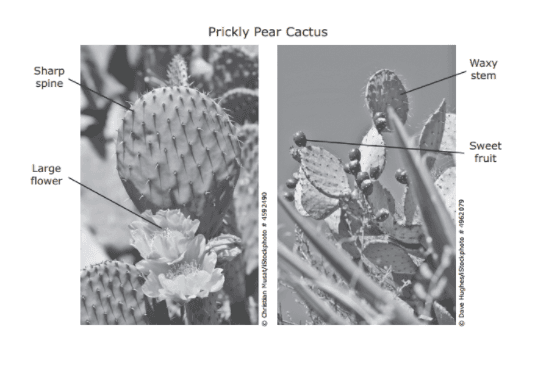
TEKS Grade 5 Science - 5.10 Diagnostic Adaptations
Quiz by Grade 5 Science - Texas Education Agency
Feel free to use or edit a copy
includes Teacher and Student dashboards
Measures 2 skills from
- edit the questions
- save a copy for later
- start a class game
- automatically assign follow-up activities based on students’ scores
- assign as homework
- share a link with colleagues
- print as a bubble sheet
- Q1
Which two traits best help a cactus conserve water in the dry conditions of a West Texas desert ecosystem?
Sweet fruit and sharp spines
Sharp spines and waxy stems
Waxy stems and large flowers
Large flowers and sweet fruit
30s5.10a - Q2
The ocotillo is a desert plant with long, straight branches. Its leaves are small and appear for only a short time after a rain. Most of the time, the branches of the ocotillo do not have leaves. Maple trees grow in areas where water is more abundant than in the desert. Maple leaves can be very large and are present for most months of the year. Ocotillo plants are better adapted for surviving in the desert than maple trees because the characteristics of ocotillo leaves —
prevent the plant from producing flowers
encourage the release of carbon dioxide from the stems
reduce the amount of water lost through evaporation
allow more sunlight to reach the soil
30s5.10a - Q3
Most kangaroos have large, heavy tails, while spider monkeys have long, thin tails. Kangaroo tails are useful when the kangaroos are hopping and also when they are crawling around on the ground to feed. Spider monkey tails are useful when the spider monkeys are moving through trees. Both of these animals use their tails primarily for —
carrying their young
attracting the attention of other animals
grabbing and holding their food
supporting and balancing their body
30s5.10a - Q4
The whiskers of a river otter and the antennae of a cockroach are shown below. How do structures such as whiskers and antennae benefit organisms?
They help the organisms fight predators.
They help the organisms eat food quickly.
They help the organisms detect their surroundings.
None of these
30s5.10a - Q5
The difference in the shape of these animals' teeth is most closely related to -
The habitat the animals live in.
The type of predators the animals have.
The type of organisms the animals consume.
The sounds the animals make.
30s5.10a - Q6
Fox squirrels live in the trees of city parks throughout Texas. Each spring they build nests of twigs and leaves in the tops of the trees. Fox squirrels are often found near park benches, waiting to be fed by visitors. For fox squirrels, which of these is a learned behavior?
Having a long, bushy tail
Having sharp claws
Taking food from people
Building a nest each spring
30s5.10b - Q7
A scientist observes sea otters using rocks to break open clamshells. Which of these investigations would best help the scientist determine whether this skill is a learned or an inherited behavior?
Observing families of sea otters over time to see whether adults that use rocks have offspring that use rocks
Raising young sea otters away from adult otters that use rocks and observing whether the young otters use rocks
Determining whether shellfish are an important food source in the diet of sea otters
Determining what sizes and kinds of rocks are used most often by sea otters
30s5.10b - Q8
Crayfish live in water and often hide under rocks or plants. They come out to look for food and will eat both plants and animals. Which of these is a trait that a crayfish most likely inherits from its parents?
The number of legs it has
The type of plants in its habitat
The average distance it travels each day
The amount of food it eats each day
30s5.10b - Q9
The caterpillars of monarch butterflies eat milkweed leaves. Milkweed leaves contain sap that is toxic to many animals but not to monarch butterfly caterpillars. This sap makes the monarch butterfly caterpillars toxic to predators and protects them from being eaten. Which of these is an inherited trait of monarch butterfly caterpillars?
The size of the milkweed leaves that the caterpillars eat
The number of leaves on the milkweed plants that the caterpillars visit each summer
The ability of the caterpillars to eat toxic leaves without being harmed
The number of milkweed leaves the caterpillars eat each day
30s5.10b - Q10
Which of these is a learned behavior of a dog?
Chewing on a bone
Begging for food
Panting on a hot day
Drinking water
30s5.10b
